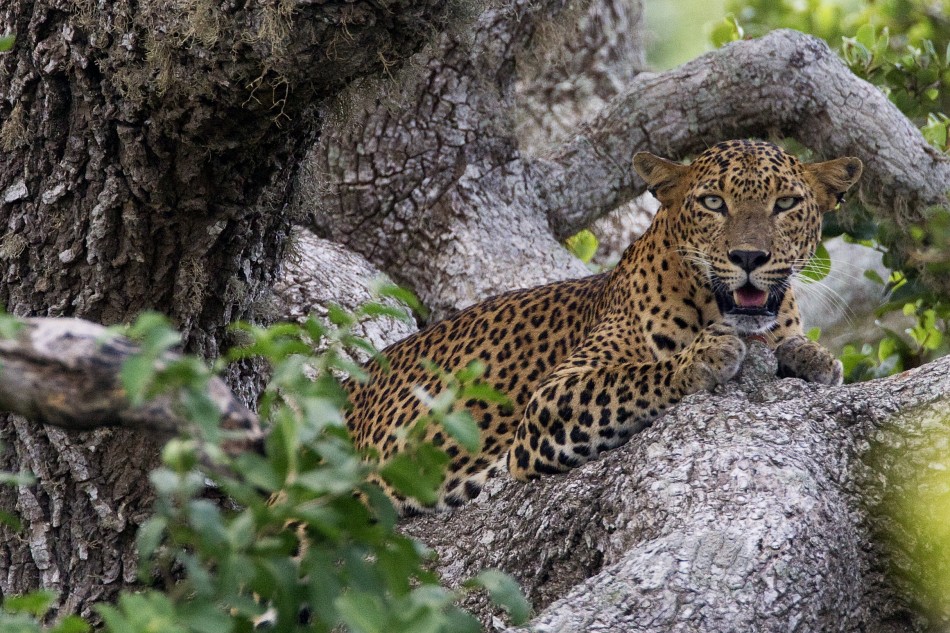
Continued from Sri Lanka Trip Report – Jan/Feb 2013 (PART I)
31st January 2013 – Nuwara Eliya and Horton Plains
An early start the next day to arrive at the Horton Plains National Park entrance for it opening to give us the best chance of seeing the whistling thrush. Around the gate in the first light of dawn were a number of Indian Blackbirds. Unfortunately, due to the location of the gate (recently moved to the edge of the park), there is only a limited window after dawn to see the Whistling Thrush on or around the main road. Upali knew of a couple of possible spots which we tried but we only got an untickable view of one flying across the road just inside the park gates. We did have better luck with the other higher elevation endemics with good views of the Sri Lanka Woodpigeon, Sri Lanka Dull Blue Flycatcher, Sri Lanka White-eye and finally the Sri Lanka Bush Warbler. The bush warbler was particularly widespread but most views were glimpses of a bird moving in dense vegetation. We did however get luckily when a warbler ventured out into the open on a branch enabling a few photographs and good views.
Main birds seen: Yellow-eared Bulbul, Bright-green Warbler, Paddyfield Pipit, Blyth’s Pipit, Hill Swallow, Sri Lanka Woodpigeon Sri Lanka Bush Warbler, Sri Lanka Dull Blue Flycatcher and Zitting Cisticola
After a bit of a walk he headed back down to Nuwara Eilya, enjoying the spectacular views that were missed in the dark of our pre-dawn ascent.
The afternoon was spent at Victoria park quickly seeing an Indian Pitta before concentrating on the area by the stream for the Pied Thrush. Some good birds were seen – Forest Wagtail, Velvet Fronted Nuthatch, Indian Blue Robin, – but only initially got a frustratingly poor view of a female Pied Thrush. Hanging around the park for the rest of the evening, we got much better view of a very attractive male Pied Thrush on the other side of the park as it came to feed on some berries. Chris stayed to try to get a photograph of the thrush whilst David and Upali went in search of the Kashmir Flycatcher – which they found. Unfortunately, it couldn’t be found when Chris got there and we had to leave before the gates closed…
Main birds seen: Forest Wagtail, Grey Wagtail, Indian Pitta, Pied Thrush, Velvet-fronted Nuthatch, Indian Blue Robin
Overnight at the ‘Binota Residency’, Nuwara Eliya.
1st February 2013 – Nuwara Eliya to Tissamaharama (‘Tissa’)
A big morning ahead, being our last chance to try for the Sri Lankan Whistling Thrush before finishing our trip in lower altitudes. An early start had us waiting in the dark at the stake-out for the thrush. Patiently waiting as the sun broke, there was no sign of it from our vantage point on the narrow path. It looked like we were going to be unsuccessful when Upali excitedly tapped us on the shoulder and beckoned us down the path where we saw a female thrush on the ground around on the edge of the path! Whilst we had been focussing on the stream and surrounding rocks in one direction, it seemed it had been gleefully hopping around behind our backs! The light was still pretty poor but I managed a few record shots before it disappeared down the valley. What a start to the day and all the more sweet given our previous disappointments – “No sweat, No sweet” indeed!
Hoping our luck was going to continue, we quickly drove to Victoria Park in search of the Kashmir Flycatcher. Starting off in the corner of the park where it was seen the night before, there was no sign but we did get a great view of 3 Pied Thrushes. Back tracking along the stream, we quickly found a brilliant male Kashmir Flycatcher – what a morning!
Leaving Nuwara Eilya after breakfast, we headed through the picturesque Ella region (home of 53 waterfalls), stopping off en route at a private garden where Upali knew of a roosting Brown Wood Owl. We quickly managed to find it but an unexpected bonus was a pair of nesting Mountain Hawk Eagles!! A great lifer for me having dipped out on this species in other locations.
Our run of luck however came to an abrupt end when Upali was ‘caught speeding’ – deemed to be 8km over the limit (1,500 SLR fine) based on a policeman’s eye sight alone, an impressive feat as no speed camera was used!

The temperature was quickly rising and vegetation was noticeably changing as we entered the dry zone closer to Tissa.
After a good lunch at our accommodation and afterwards good views of a Blue-faced Malkoha, we headed to some nearby lakes for a spot of waterbird watching. A good cross section of birds were seen, all adding to our trip list!
Main birds seen: Yellow Bittern, Cinnamon Bittern, Watercock, Black-crowned Night Heron, Gull-billed Tern, Asian Koel, Blue-faced Malkoha, Brown Wood Owl, Brown-headed Barbet, Forest Wagtail, Pied Thrush, Kashmir Flycatcher and Sri Lanka Whistling Thrush
Overnight at the ‘Hibiscus Garden Hotel’, Tissamaharama.
2nd February 2013 – Yala National Park
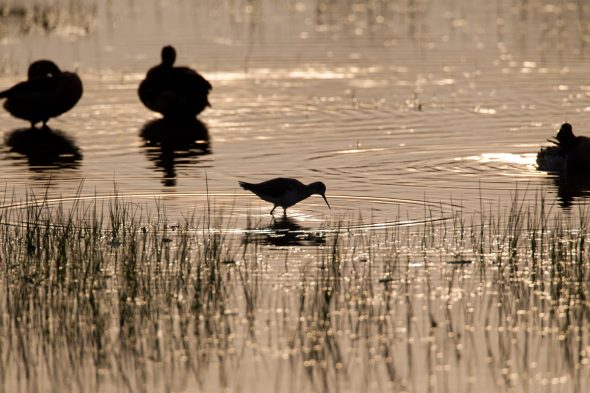 A pre-dawn departure to arrive at the gates to Yala NP by opening time. Once off the main tar road, the drive was interesting, even outside the park. The road skirted some pans which contained large numbers of roosting waders – identifying them was however tricky due to the position of the sun. Also seen outside the park was a magnificent bull elephant – ignored by all of the other jeeps racing to the entrance gate. Jeeps racing around was to be a feature of our trips to Yala…..
A pre-dawn departure to arrive at the gates to Yala NP by opening time. Once off the main tar road, the drive was interesting, even outside the park. The road skirted some pans which contained large numbers of roosting waders – identifying them was however tricky due to the position of the sun. Also seen outside the park was a magnificent bull elephant – ignored by all of the other jeeps racing to the entrance gate. Jeeps racing around was to be a feature of our trips to Yala…..
Despite the crowds queuing for permits at the gate, Upali and our driver did a good job of finding some solitude in the park. Being our first day, we had a leisurely drive enjoying all the commoner species before heading to the picnic area for lunch. This spot was the site of a couple of government bungalows until they were destroyed by the 2004 Tsunami. A memorial now stands for the 47 lives lost at this spot – the majority of which were picnicking tourists, exactly what we were doing now.
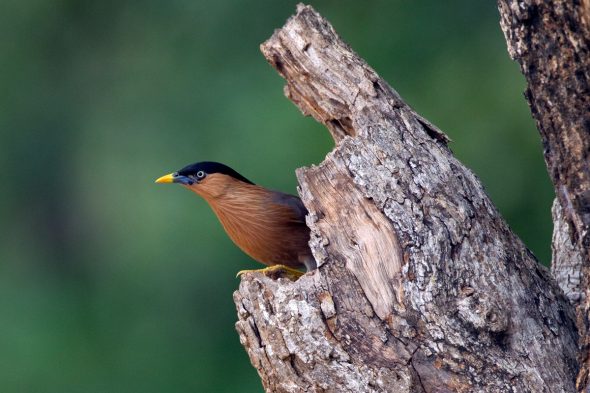
After lunch, we got wind of a leopard sighting so we headed in that direction. The sleeping leopard was duly sighted and our patience in the sun paid off when it descended the tree for a drink in a nearby pool. The wait also yielded a small flock of Brahminy Starlings – beautiful birds.
The afternoon was spent exploring the park before heading out before the gate closed. A long, bumpy but rewarding day with a good range of birds seen including a Sirkeer Malkoha in full view on the road for a few brief moments, plus a decent list of mammals.

Main birds seen: Painted Stork, Crested Serpent Eagle, Changeable Hawk Eagle, Barred Buttonquail, Painted Snipe, Yellow-wattled Lapwing, Orange-breasted Green Pigeon, Sirkeer Malkoha, Indian Nightjar, Yellow-crowned Woodpecker, Jerdon’s Bushlark, Ashy-crowned Sparrow Lark, Brahminy Starling, Rosy Starling, White-throated Silver bill
Overnight at the ‘Hibiscus Garden Hotel’, Tissamaharama.
3rd February 2013 – Yala National Park
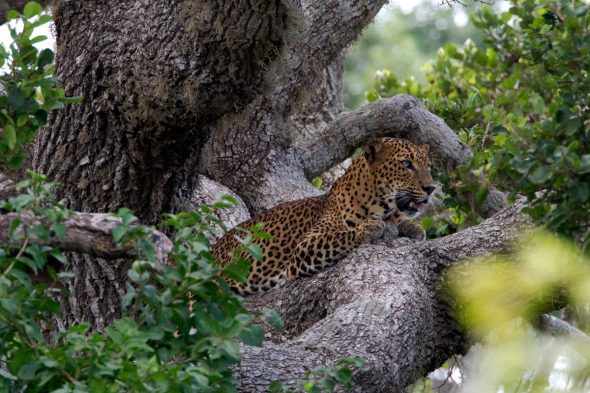
A repeat of the prior day with another full day trip to Yala planned. Again, our driver did a great job of finding the quieter spots with no other cars seen at all during our morning drive until we hit an area where a leopard had just been sighted. After struggling for a view, we hung around after the hoards had departed, gambling on the leopard making another appearance when things had quietened down. This paid off handsomely as the leopard climbed a prominent tree and lay in full view for a short period.
After lunch, there was a bit of racing around following up rumours of leopard sightings and we managed to get a relatively poor view of a male in a tree. We also picked up some different birds from the first day including Lesser Adjutant, Jacobin Cuckoo and Black-headed Cuckooshrike.
Main birds seen: Lesser Adjutant, Eurasian Spoonbill, White-bellied Sea Eagle, Jacobin Cuckoo, Black-headed Cuckooshrike, Flame Minivet, Purple Sunbird, Baya Weaver
Overnight at the ‘Hibiscus Garden Hotel’, Tissamaharama.
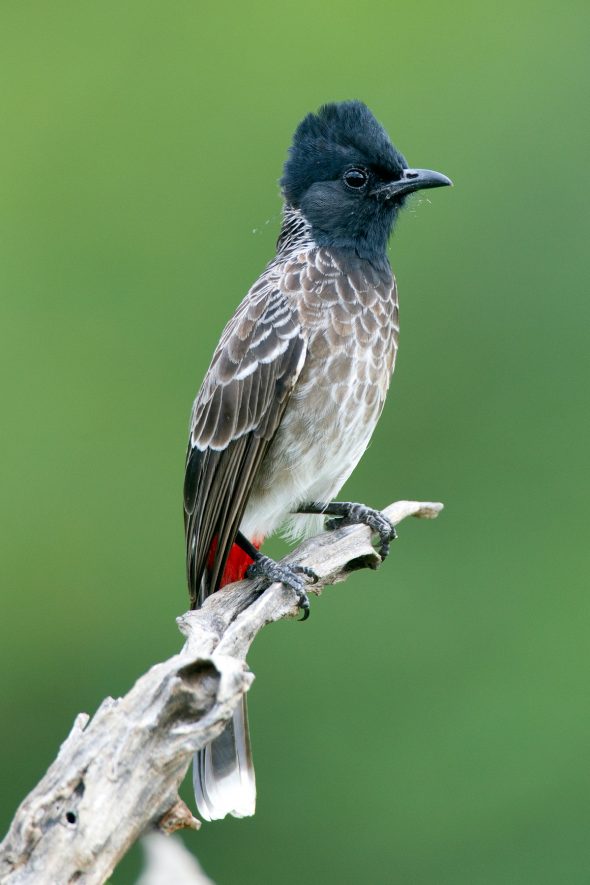
4th February 2013 – Tissa to Sinharajah Rainforest
We opted to head to the nearby reservoirs before breakfast to try and pick up some waterbirds missed so far on the trip. We started off well picking up a Black Bittern as well a numerous Cinnamon Bitterns squabbling over roosting sites.
Grateful for comfy seats after two days on bouncing around on the wooden benches of the jeep, we left Tissa after breakfast for Sinharajah. As usual, Upali knew of a few spots en route to try for a few things of interest. Unfortunately, the resident Scops Owl wasn’t in its usual spot at the Elephant refuge.
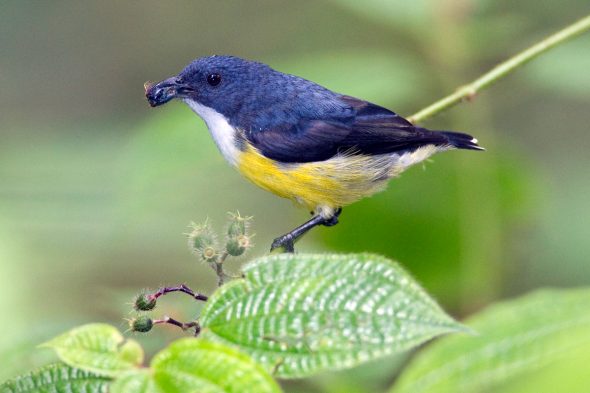
Arriving late afternoon, we concentrated on birding around the lodge itself, getting back on the endemic trail with good views of Sri Lankan Myna, Sri Lankan Drongo and Legge’s Flowerpecker.
Main birds seen: Yellow Bittern, Cinnamon Bittern, Black Bittern; White-bellied Sea Eagle, Black Eagle, Layard’s Parakeet, Black-headed Yellow Bulbul, Black Bulbul, Brown-breasted Flycatcher, Legge’s Flowerpecker, Sri Lanka Myna
Overnight at the ‘Martin’s Lodge’, Sinharaja.
5th February 2013 – Sinharajah Rainforest
Our first day proper at Sinharajah, the plan was to walk down to the entrance gate to buy tickets before heading back up the hill to the part entrance and walking the trail to the research centre. We also picked up the compulsory park guide but Upali had done well, securing the services of a birding expert whose local knowledge proved to be excellent.
Over a pre-dawn breakfast at the Lodge, we got great views of the resident Spot-Winged Thrush and Sri Lankan Blue Magpies – the latter hawking insects above our heads in the restaurant!
The morning walk was a leisurely affair, designed to pick up as many of the Sinharajah specialties as possible. The birding was typically ‘rain-forest’ i.e. quieter periods then very frenetic when a bird wave was seen. More and more of the gaps on our endemic list were being filled – Red Faced Malkoha, Ashy Headed Laughing Thrush and finally a White-Faced Starling.
The most fortuitous bit of luck was hearing, then finding, a pair of Green Billed Coucals whilst looking for a Scaly Thrush. After all the misses at Kitulgula, it was a relief to find this elusive endemic.
Main birds seen: Besra, Red-faced Malkoha, Green-billed Coucal, Sri Lanka Grey Hornbill, Yellow-fronted Barbet, Yellow-browed Bulbul, Dark-fronted Babbler, Orange-billed Babbler, Ashy-headed Laughing Thrush, Asian Brown Flycatcher, Pale-billed Flowerpecker, White-faced Starling, Sri Lanka Blue Magpie
Overnight at the ‘Martin’s Lodge’, Sinharaja.
6th February 2013 – Sinharajah Rainforest
After yesterdays success in picking up the majority of the outstanding endemics, the day was focussed on picking up the remaining birds – Serendib Scops Owl, Sri Lankan Spur Fowl and Scaly Thrush.
The day didn’t start well with news that the Serendib Scops Owl still couldn’t be found in it’s usual daytime roost in the park. And the Scaly Thrush wasn’t showing in any of its normal spots on the way out to the Research Centre, although there was the compensation of great views of a Spot-winged Thrush singing close to the trail. The last reliable spot for the Scaly Thrush was close to Research Centre and our guide patiently spent over half an hour searching the area. Just as he was giving up, he heard a faint whistle and managed to pick up the thrush hidden in the gloom. This must be one of the most lethargic birds ever – having to rest for a long period after taking more than a couple of steps. After watching it for about an hour, it finally worked its way in an open area where we were able to get great views before it was forced into turn of speed when it was chased off by a Sri Lankan Junglefowl!
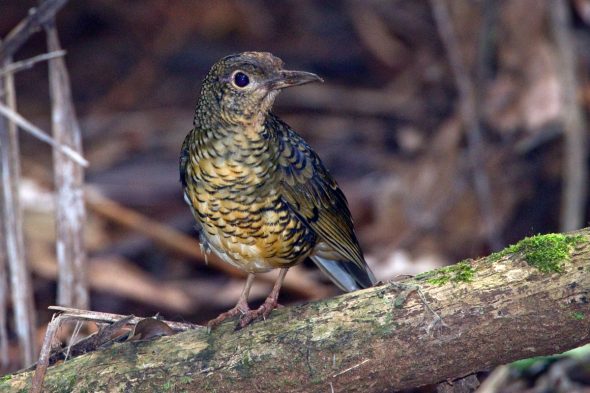
Heading back to the gate, our guide had found the Sri Lankan Frogmouth in their local roost and we got news that a Serendib Scops Owl had been found just outside the park. After a quick lunch, we started the long hot walk to the spot – trying to beat the approaching storm. We met another forest ranger who had found the owl after being out at 4am and pin-pointing the new roost from its call. The path down to the owl started off easily enough but it soon go tricky with a 12 foot near vertical drop but David easily negotiated by inadvertently sliding down it on his bum! Carefully stepping through some bamboo, the ranger beckoned us up one at a time to see the owl. It took a moment to pick it up as it was a lot closer than expected. The light was now terrible and the rain was starting but Chris managed to get a few photos of the owl – this individual is one of an estimated global population of just 250 birds.
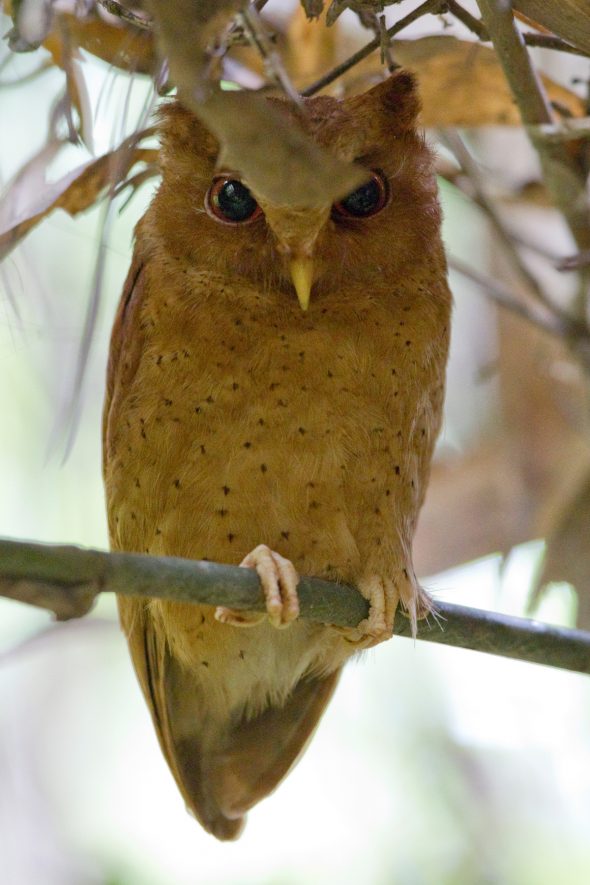
The scramble back up the slope was more of a challenge but we made it back up as the heavens properly opened. It was a long and very wet walk back up to Martin’s Lodge, not that we minded after the morning we had had. The rest of the afternoon was a wash out and we had one endemic to go and one morning to get it in!
Main birds seen: Serendib Scops Owl; Sri Lanka Frogmouth, Malabar Trogon; Indian Pitta; Indian Blue Robin; Spot-winged Thrush; Sri Lanka Scaly Thrush; Sri Lanka Scimitar-babbler

Overnight at the ‘Martin’s Lodge’, Sinharaja.
7th February 2013 – Sinharajah to Mirissa
We had heard the scrub fowl calling just below Martin’s Lodge so the initial plan was to head down and stake out the area at dawn. That plan was soon foiled by being beaten to the spot by another group of birders after the Chestnut Backed Owlet! Moving onto plan B, we headed further down the hill outside the park to another stake out known by Upali and we quickly had success with a female Scrub-fowl rushing in response to a short burst of playback. It ended up being a quick conclusion to our quest and we were in a very relieved and relaxed mood as we headed back for breakfast. As things often go, we bumped into another scrub fowl on the way back – a nice male this time, foraging by the side of the road!
It was a nice drive down to the coast after breakfast and we arrived in the historic and picturesque town of Galle in time for a good lunch at the Rampart Hotel. It was then a short hop to our hotel in Mirissa and an afternoon to relax.
Main birds seen: Sri Lanka Spurfowl, Crested Serpent Eagle, Sri Lanka Swallow, Plain Prinia
Overnight at the ‘Bay Beach Hotel’, Weligama.
8th February 2013 – Whale Watching
The last main highlight of our trip was a chance to head out on a whale watching sea trip. More details about the trip can be found in a separate post but suffice to say our expectations were blown out the water with well over 10 individual Blue Whales were seen plus a pod of over 300 Spinner dolphins seen at close quarters. It is hard to describe and capture the immense size of the whales and how calm and dignified they behaved. A real wildlife ‘must-see’ – a fantastic experience.
Overnight at the ‘Bay Beach Hotel’, Weligama.
9th February 2013 – Mirissa to Colombo and departure
The morning was originally planned as a contingency in case our scheduled whale watching trip had been unsuccessful but we decided that we wouldn’t be able to top yesterday and opted for a leisurely drive back to Colombo. That gave us time to stop off at a few spots along the way including a turtle hatchery and a few wetland areas. Unfortunately we hit a heavy thunderstorm just outside Colombo and the last spot Uplai wanted to show us was a washout – a shame as it looked like a promising area of farmland which could have yielded a few more species for the trip.
In the end, we ended up with a very satisfying trip list of 215 which included all 33 Sri Lankan endemics plus a good number of birds that would probably be difficult to find anywhere else e.g. Kashmir Flycatcher, Sri Lankan Frogmouth. We also had seen a good list of mammals and had been well looked after by Upali who had done a great job of showing us as much as he could in the time available. There certainly seems to be a lot more to see and do in Sri Lanka although we would not have wanted to change our itinerary at all – all pointing to needing a return trip to take in the North and spend more time in the cultural heartland of the country.

